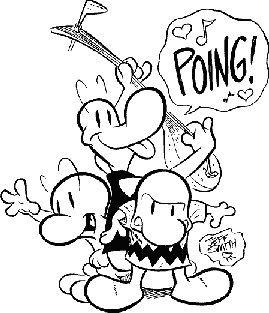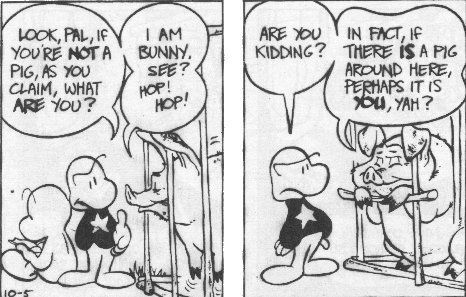|
Jeff Smith's Bone: An Exhausting
Self-Indulgent Retrospective
What’s
your earliest memory of Bone?
Mine actually has nothing to do with an
actual reading experience.
The
first job I ever had was at a comic shop where they chained
me up to my station at the register. Well, metaphorically
chained me up - point is I had to sit there for long periods
of time, responsibly handling money until the boss unleashed
me to play Magic: The Gathering with loitering regulars
or just paid me in merchandise like the pathetically unskilled,
desperate young teenager I was.
Anyway,
my shift was during the only three hours the shop got busy,
so I spent most of the time between helping customers staring
into space or, more often than not, at the Bone
poster on the opposite wall (though I will admit that, at
the time, my raging hormones would’ve preferred the
Gen-13 poster in the stock room).
The picture showed a refreshingly not-sickening,
cuddly cartoon character sitting in a meadow, reading a
book as the sun shone through the trees and played about
the blades of grass around him. It felt like something out
of a dream or one of those perfect mornings where you’re
up in time for the sunrise. There were no guns, mutants,
or women who looked like they modeled for truckflap silhouettes
(which, again, might not have been such a bad thing, at
the time); just a sweet, innocent image that called out
to the not-quite-dead child in me.
But
my boss stopped ordering Bone and dozens of other
comics as Magic: The Gathering filled the void left by comic
and baseball card collecting when their markets crashed.
Eventually, my favorite (again, possibly second favorite)
image came down to make way for a Star Wars Collectable
Card Game promo. The boss rolled the poster up and took
it home for his nephew. I never got a Bone comic
while working at the store.
But
that picture haunted me until I finally gave in and hunted
Bone down like a fiend, feeding my desire and leaving
me constantly thirsting for more of the wonderful world
the comic opened up to me.
And,
now that the saga has come to an end in recent weeks, (with
creator Jeff Smith moving onto Shazam! for DC -- ed.),
I think it’s time to encourage that same hunger in
you, dear readers…
The
Story
Bone
is the tale of the Bone cousins, three cartoony characters
who get run out of Boneville when Phoney Bone’s (the
greedy one with the star shirt) latest crazy scheme goes
horribly wrong.
After
drinking the last of their water, Smiley Bone (the lanky,
cigar-smoking, happy-go-lucky ne’er do well) finds
a map in the harsh desert terrain that indicates a valley
not too far off. Then a swarm of locusts descends up on
the cousins, scattering and separating them.
Fone Bone (the nice one who’s kinda…
well, naked) follows the map toward the valley, hoping to
meet up with his cousins, but instead discovers a sylvan
paradise populated by talking animals, medieval villagers,
ferocious monsters, a cigarette-smoking dragon, the mystery
of a fallen kingdom, and the girl of his dreams.
It’s hard to say exactly what makes
Bone such a genius piece of work because so many things
work so well.
At a
time when vicious cross-hatching and jagged edges were the
norm in the industry, Jeff Smith came onto the scene with
an art style in such complete opposition to the status quo
it seemed brilliantly unique.
The
clean, smooth lines of the Bone cousins juxtaposed against
the gorgeous and often intricate backgrounds of the valley
combined traditions too long lost to American comics and,
indeed, brought Bone to the attention of European
audiences. They compared it to The Sandman and
Watchmen and readily translated the work into numerous
languages.
The dialogue itself is often cited as one
of the great joys of reading the series. Clear and flowing,
every character’s speech is unique, rich, and enjoyable.
Even minor ones who round out the cast; ESPECIALLY so in
the case of bit parts and villains.
Bone’s
comedic timing and joke set-ups have become the stuff of
legend in the comic community. Insertion of morals and philosophy
is logical and rarely heavy handed, leaving many readers
blissfully ignorant that they just got a life-lesson.
However,
Smith’s handling of dialogue was certainly a process
that evolved over the years. When the book started, almost
every character spoke in the same colloquial American style,
contracting one syllable words and generally talking in
a manner reminiscent of old Popeye or Krazy
Kat strips (though never as indecipherable as some
of Krazy Kat creator George Herriman’s speech
has become to modern eyes).
As the
series continued, that dialect was dropped by all characters
except Ted the Bug. More serious characters adopted a classical
mode of speech while casual ones, like the Bones, slowly
got closer to the vernacular. The result makes for a bit
of a hiccup if you read the series all at once, since the
book is otherwise remarkably consistent for a project spanning
12 years, but it’s easy to forgive when you consider
how the scope of the book evolves.
Bone’s
great claim to fame, however, is the flow of the scenes.
Influenced by Smith’s years as an animator, sequences
move with a clarity rarely seen in graphic narrative. In
fact, many comic creators would insist that such exercises
are better suited to motion pictures.
Jeff Smith’s mastery of chase scenes,
races, battles, reveals, and dream sequences proves not
only that there’s a place for extended “action”
sequences in comics but that they can harness the reader’s
imagination to create visuals equal and superior to those
seen in the best movies and television have to offer.
The
History
Bone started out as the simple scribblings
of a boy in kindergarten. A few crudely drawn characters
engaging in childish, silly stories. Nothing to get excited
about. Just the musings of a kid in love with the magic
of cartoons.
But,
as that boy grew older, the characters stayed with him,
morphing and evolving around his adolescence, staying true
to their Warner Bros./Disney cartoon origins while absorbing
elements of Carl Barks’ Uncle Scrooge, Walt
Kelly’s Pogo Possum, and Charles Schultz’s
Peanuts. Sure, the humor was now on a teenage level,
but the strong foundation remained true.
By puberty’s end, the characters coalesced
into the Fone Bone, Phoney Bone, and Smiley Bone we know
today.
When
Jeff Smith went off to college in 1982, he took his creations
with him and started a comic strip called Thorn
in the Ohio State University student paper, The Lantern.
The endeavor moved him even further away from the “joke-a-day”
stylings of most strips as he delved into an ongoing story
where threads continued for months and a prototype version
of Bone was tested out. Needless to say, the formula worked.
In fact, a lot of scenes and gags from Thorn were
re-used and refined in Bone.
Unfortunately,
Smith’s plan to syndicate Thorn as a daily
newspaper strip fell apart when offers came in for a humor
comic rather than the adventure story he wanted to tell. His
interest in the series faded, and he and some college friends
founded the Character Builders animation studio in 1986 (after
training themselves from Frank Thomas and Ollie Johnson’s
book The Illusion of Life: Disney Animation).
The
studio work consisted of making local ads and eventually
gave way to work on big Hollywood productions like Bebe’s
Kids and Rover Dangerfield (neither of which
Smith and company take responsibility for). Doug
and other TV series farming out work started looking to
Character Builders, and business was looking pretty good.
But the Bone cousins were far from dead.
Despite
the huge animation boom in the early ‘90’s,
Smith started work on the Bone series in 1991 and
founded Cartoon Books. When directing commercials and doing
animation at Character Builders didn’t leave enough
free time to work on the comic, he and his wife Vijaya decided
they could get by on her income alone, so Smith sold off
his interest in Character Builders to produce the bi-monthly
Bone full time.
Early
sales weren’t stellar, to say the least, but Smith
kept with the book, despite falling monthly orders. However,
support from Will Eisner and Neil Gaiman got word of mouth
started, and previews run in Comic Buyer’s Guide and
by Dave Sim in Cerebus started the exponential
climb in sales that put Bone on the map.
Independent books now had a 17% share of
the marketplace and the ‘90’s comic boom was
reaching its peak. Smith convinced his wife to quit her
high paying job in Silicon Valley to help him run the comic.
In 1993,
Bone won its first Eisner Award for Best Humor
Publication and, as internet communications got going, word
of Bone spread around the globe, and it became
one of the first comics to benefit from online chatting
(which also helped the book spread into so many foreign
markets).
Then
the bubble burst.
Next
week: The Image Years...
|








